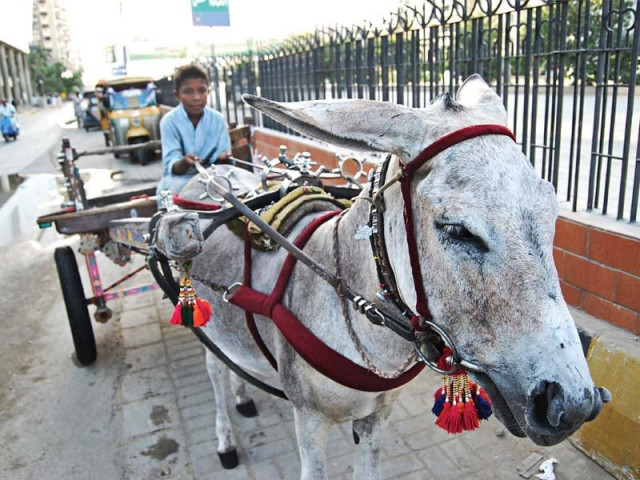Dashing donkeys, magnificent mules
Residents from other cities constantly complain that everyone in Karachi is always racing.

Every alternate Sunday afternoon, small chariots attached to mules and donkeys line up alongside the curb on the main road in preparation for the big race. A crowd of several dozen enthusiasts gathers around the chariots, many on donkey-carts themselves, with others arriving on small pickup trucks that can follow the racing chariots till the end of the race.
The people gathered are mostly associated with the transportation business. When they are not racing, these donkeys and mules are pulling large carts loaded with grain at Jodia Bazaar or scrap metals at the market in Shershah. Many have been in the business for decades and have been racing their animals for just as long.
“I’ve been coming here since I was a child,” says Ismail, a donkey owner. “I used to come with my father. And my father used to go to the race with his father when he was a child. Now I am coming with my own children.”
Most of the racers, as well as the audience, belong to the Katchi and Makrani Baloch communities residing in Lyari. For them, the race is akin to a festival where people come with their children, though no women attend. And such is its popularity among its fans that, according to one spectator, the “races were even filmed by the National Geographic Channel.”
There are two starting points for the participating chariots: the billboard in front of The Forum and the railway crossing at one end of Mai Kolachi. The race ends at the point where the Native Jetty Bridge begins. There are usually two to three races at every event.
As with most races involving animals, there is indeed gambling involved. In fact, organisers of the event make money primarily by arranging bets between members of the crowd gathered to watch the race. Surprisingly, the winner does not receive reward money from the organisers; instead the owner of the losing donkey pays, typically an amount exceeding Rs50,000.
And where illegal money is involved, the police are also not far behind; they are paid hefty sums in bribes to get them to keep their noses out of the races and thus allow rampant gambling to take place.
The races are usually a donkey versus donkey contest, or a mule versus another mule. It is rare for a race to be organised between a donkey and a mule but when they do take place, they attract a lot more attention since the odds of a mule winning are typically much higher than that of a donkey.
The donkeys and mules involved in the races are often decorated, and owners say they feed and treat their race animals better than their work animals. The prices for race animals are also much higher, especially for husbandry purposes (when the semen of a male donkey is sold to the owners of a female donkey for impregnation).
A weak economy, however, has taken its toll. The race used to be held weekly, but now it takes place every other Sunday; once at Mai Kolachi and the next week at the Ghaghar Railway Crossing on the National Highway. The new US Consulate on Mai Kolachi has also caused problems because the police have been hesitant in allowing large gatherings so close to the consulate.
In Lyari, where the residents are particularly enthusiastic about these races, donkeys have had to pay the highest price. As many as 25 donkeys, a lot of them reared for these races, were caught in the crossfire in Karachi’s summer of violence in May. The violence forced the Lyari Donkey Cart Association to cancel the Hamara Karachi race that carried a prize-money of Rs50,000.
Despite the loss and insecurity, the races continue with just enough fervour and festivity. In fact, if the sport were given a spot in the Olympics, Pakistan would have a sure shot at the Gold!
Published in The Express Tribune, Sunday Magazine, October 28th, 2012.
Like Express Tribune Magazine on Facebook and follow at @ETribuneMag



















COMMENTS
Comments are moderated and generally will be posted if they are on-topic and not abusive.
For more information, please see our Comments FAQ